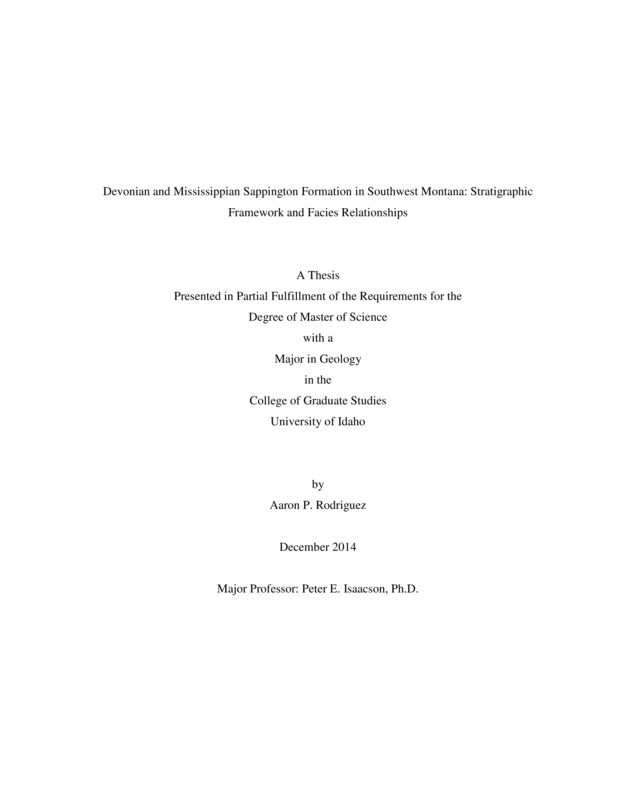Devonian and Mississippian Sappington Formation in Southwest Montana: Stratigraphic Framework and Facies Relationships
Rodriguez, Aaron Paul. (2014). Devonian and Mississippian Sappington Formation in Southwest Montana: Stratigraphic Framework and Facies Relationships. Theses and Dissertations Collection, University of Idaho Library Digital Collections. https://www.lib.uidaho.edu/digital/etd/items/rodriguez_idaho_0089n_10469.html
- Title:
- Devonian and Mississippian Sappington Formation in Southwest Montana: Stratigraphic Framework and Facies Relationships
- Author:
- Rodriguez, Aaron Paul
- Date:
- 2014
- Keywords:
- Bakken Devonian Mississippian Montana Sappington Stratigraphy
- Program:
- Geology
- Subject Category:
- Geology; Sedimentary geology
- Abstract:
-
Hydrocarbon production success from the Bakken Formation of the Williston Basin has led to interest in time-equivalent Devonian-Mississippian strata. One of these Bakken-equivalent formations is the Sappington Formation of western Montana. This regionally <30 ft. to >120 ft. thick mixed carbonate and fine-grained siliciclastic unit occurs between thick Devonian and Mississippian carbonates and was deposited in the low-accommodation intracratonic Sappington Basin of the Central Montana Trough (CMT). Differential foreland subsidence and uplift of the CMT resulted in changing depocenter geometries. Despite the tectonic and paleogeographic differences between the Sappington Basin and the Williston Basin, the Sappington and Bakken share similar intracratonic depositional elements.
This study focused on outcrop Sappington sections in the Three Forks, Montana area. Regionally, the Sappington pinches out to the south and northeast onto the paleogeographic highs of the Beartooth Shelf and Central Montana Uplift. To the west, correlation of Sappington and Antler Foreland Basin units have been complicated by Sevier and Laramide deformation. Within the Sappington Basin thinning and lateral facies relationships suggest significant early western accommodation of facies with potential for local proximal variations.
Similar to the coeval Bakken Formation, the Sappington's three members (Lower, Middle, Upper) are separated by abrupt facies shifts and unconformities. The Lower and Upper Members both display black organic preservation during periods of quiescent anoxic bottom water conditions. Such conditions were driven by early Gondwanan glaciation producing widespread equatorial Late Devonian eustatic effects. The Middle Member is a well oxygenated mix of wave and tidal dominant energies located within the shoreface regime.
The low-accommodation intracratonic character of the Sappington Basin complicates establishment of a sequence stratigraphic framework. Episodic flooding and draining of the Sappington Basin is represented by four prominent unconformities within a succession of rocks averaging 75 ft. in thickness and with a depositional timeline of ~8 million years. Subsequently, lowstand system tracts deposits are not observed in the study area and are represented by stacked sequence boundaries and transgressive surfaces.
This study focuses on outcrop Sappington sections oriented in the up- and down-dip directions between the western Montana towns of Whitehall and Livingston. Regionally, the Sappington pinches out to the south and east onto the paleogeographic highs of the Beartooth Shelf and Central Montana Uplift. To the west, the CMT correlates to units in the Antler Foreland Basin where the location/existence of a true shelf break is speculative. Within the CMT thinning and lateral facies relationships indicate an eastward distal to proximal transition. The Sappington's three members (Lower, Middle, Upper) are separated by unconformities and express unique depositional character. The Lower and Upper Members both display black organic preservation during periods of quiescent anoxic bottom water conditions. Such conditions were driven by Early Gondwanan glaciation producing widespread equatorial Late Devonian eustatic effects. The Middle Member is a well oxygenated mix of wave and tidal dominant energies located predominantly within the shoreface regime.
The low accommodation intracratonic character of the CMT complicates establishment of a sequence stratigraphic framework. Episodic flooding and draining of the CMT is represented by four prominent unconformities within a succession of rocks averaging 75 ft in thickness and with a depositional timeline of ~8 million years. Subsequently, lowstand system tracts deposits are not observed in the study area and are represented by stacked sequence boundaries and transgressive surfaces.
- Description:
- masters, M.S., Geology -- University of Idaho - College of Graduate Studies, 2014
- Major Professor:
- Isaacson, Peter E
- Committee:
- Grader, George W; Cassel, Elizabeth J
- Defense Date:
- 2014
- Identifier:
- Rodriguez_idaho_0089N_10469
- Type:
- Text
- Format Original:
- Format:
- application/pdf
- Rights:
- In Copyright - Educational Use Permitted. For more information, please contact University of Idaho Library Special Collections and Archives Department at libspec@uidaho.edu.
- Standardized Rights:
- http://rightsstatements.org/vocab/InC-EDU/1.0/

